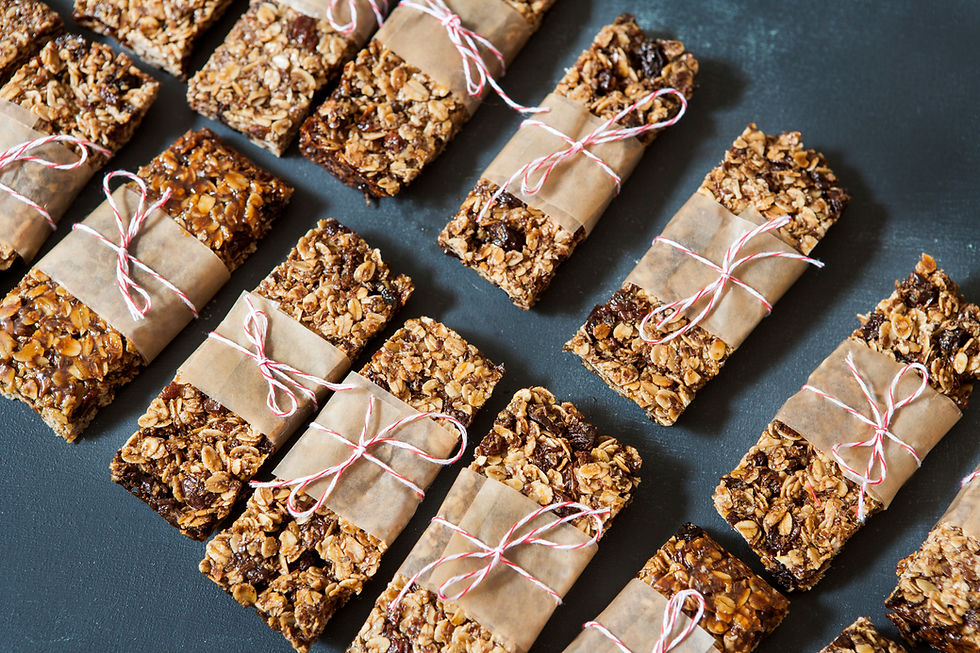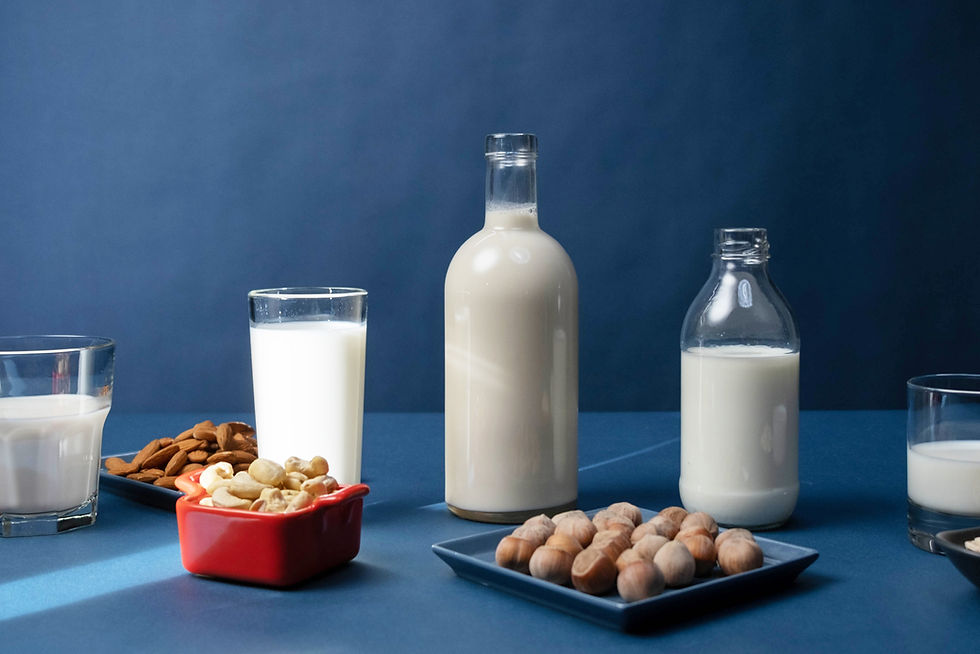Top 5 Brain Boosting Nutrients for Kids
- Sylvia Meo, R.D.

- Oct 8, 2020
- 8 min read
Updated: Apr 11
Did you know that foods and proper nutrition are critical to normal brain development in early childhood and are linked to academic performance? Research has shown links between breakfast consumption and better academic performance, but it has also shown a negative correlation between the overall poor quality of a child’s diet and academic performance (1). What this suggests is that children whose diets lack fruits, vegetables, proteins, whole grains and healthy fats may be lacking the important nutrients that are essential to brain development, cognitive function, behavior and inevitably, good grades.
Here are my top 5 brain-boosting nutrients to support our children’s short and long-term brain function throughout their academic life.
1. Antioxidants
The brain is highly susceptible to oxidative stress, but a diet rich in antioxidants can protect it from this damage because antioxidants have been proven to reduce inflammation, cellular stress and improve communication between brain cells. Kids love to eat in color, but did you know that bright colored fruits and vegetables are also a tell-tale sign that they are rich in antioxidants? Antioxidants are found naturally in food, but particularly in deep, dark and bright-colored fruits and vegetables. In fact, blue and purple colored foods are known to help enhance memory.
Current fruit and vegetable intake in children is less than ideal, most don’t even consume the recommended 5 servings a day, and this includes both fresh or frozen produce. In fact, frozen fruits and vegetables are nutritionally equivalent, if not better than fresh because they are picked at their peak ripeness when they are most nutrient dense. Just read the ingredient list and make sure there are no unwanted ingredients, like added sugar or sodium.

One of the best ways to get kids to eat more of anything is by involving them in the process: the planning, the shopping, the preparing and the making of the meal or dish. Also, make sure fruits and vegetables are always available, cut them up ahead of time for their snacks and lunches, and add some or even sneak them in wherever you can. I am all for sneaking them into a soup, pasta sauce, muffin or cake recipe, or even pureeing a mixture fruits and vegetables into a delicious puree or smoothie! Finally, offering a healthy dip as an accompaniment is always a winner: sliced fruit with yogurt or some nut or seed butter, cut up veggies with hummus or salsa.
Antioxidants can also be found in whole grains, legumes (peas, beans, lentils), nuts, seeds, herbs and spices.
2. Healthy Fats
Our brain is 60% made up of fat, so it is no surprise that healthy fats such as omega 3 fats are vital for brain health. Omega 3 fats help build and repair brain cells, but also have anti-inflammatory effects. A 2017 study (2) found that individuals with higher levels of omega 3 fats had better blood flow in the brain, better cognition or thinking abilities. While other studies have linked omega 3 fats in helping manage behavioral problems, improved reading ability and memory function.
Eating foods rich in omega 3 fats clearly may boost brain function and oily fish such as salmon, mackerel, herring, sardines, anchovies and tuna are excellent sources of omega 3 fats. They make a great filling for a pita bread or tortilla wrap, they can be turned into fishcakes or burgers, or mixed into a tomato sauce and served on pasta! Of course, not every kid is like my Trinity and loves a variety of fish (but I do still struggle with some like all us parents). I need to make sure I hide the anchovy bottles properly in the refrigerator or else they would disappear at record speed. Fish is not an easy food to get kids to love, I get that, my number one tip is you should introduce fish as early as possible and often to help your child develop a taste and liking for it. Tuna is usually a crowd favorite, just make sure to get light tuna which has a lower mercury content than white or yellow tuna.

A foolproof method to ensure my daughter meets her weekly servings of healthy fish, which also serves as an excellent option for school lunches, particularly when we're pressed for time or short on ideas, is using canned light tuna or salmon salads available at all major grocery stores. Many contain high quality light tuna or wild salmon, select legumes, grains and/or vegetables. Pair it with a fruit and yogurt and you have a hassle-free, healthy meal ready in seconds! When we are the go, I always grab one and throw it in my purse, just in case!
3. Fiber
The brain uses roughly 20% of our daily calories and mainly in the form of carbohydrates, in fact only in a situation of starvation or deprivation will the brain use another source of energy as fuel. Thinking, learning and memorizing are all dependent on glucose (the broken-down form of digested carbohydrates). I am not saying that consuming high sugared beverages and foods all day is the way to go, quite the contrary because high blood sugar levels have been linked to impaired memory and cognitive deficiencies (3).
Much like in the case of luxury cars, our brain works best when it gets premium fuel, more specifically complex carbohydrates: whole grains, fruits, vegetables, legumes, as well as nuts and seeds. Complex or high fiber carbohydrates take longer to digest than refined or processed carbohydrates thus providing a steadier source of energy to the brain which is ideal. That fiber also feeds our good gut bacteria, a recent study has linked a healthy microbiome to long lasting effects on learning and cognition (4). Furthermore, high fiber foods are more satiating, and when our kid’s bellies are full, their minds are free to concentrate and learn.

To maintain stable blood sugar levels between meals, it's important to choose healthy, nutrient-dense snacks that are low in sugar, high in fiber, and include some protein and other beneficial nutrients. Examples include hummus and veggies, cheese and whole grain crackers, Greek yogurt topped with fruits. I also love having a convenient, pre-packaged option on hand, but it must align with my Foodful standards: low in sugars, especially added sugars, yet be a good source of fiber, contain some protein, be peanut and nut-free...clearly it can be challenging to find. So far, most Healthy Crunch Granola Bars check all my boxes. They are low in sugar, high in fiber, contain some protein and gut-healthy probiotics, and are free from allergens, peanuts, and tree nuts, with School-Approved® status. Each bar also offers one serving of fruits and vegetables!
4. Protein
Protein is incredibly important because when combined with other foods it helps ensure their energy is released more slowly and blood sugar levels are maintained more stable. We have seen above why this slow and steady release is so important: our child’s concentration levels are improved, as well as thinking, learning and memorizing. Protein-rich foods (lean meats, poultry, fish, eggs, dairy products, nuts, seeds, legumes, etc.) often also contain vitamins and minerals, which are important for various brain functions like the growth, repair and development of the cells. With 90% of a child’s brain developing from birth to 5 years of age, it's safe to say that protein-rich foods play an important role in their diet. Since most of us are familiar with using and adding lean meats, poultry, fish, eggs and dairy products to our kid’s diets, I thought I would focus mainly on seeds and legumes.

Roasted chickpeas, as well as pumpkin or sunflower seeds, make excellent snacks. Beans can be added to soups and salads, and lentils can enhance a simple tomato pasta sauce with healthy protein. I always aim to have options that simplify meal preparation on days when I don't feel like cooking, and keeping a couple of boxes of legume pasta in my pantry has certainly been a lifesaver!
Unfortunately, since nuts are typically prohibited in schools, we frequently overlook nuts and seeds that don't belong to the peanut and tree-nut category, even though they are an excellent source of healthy fats and protein. Seed butters that are School-Approved® (free of major allergens and made in a gluten-, peanut- and tree-nut free facility), like Healthy Crunch Seed Butters, can be extremely convenient while also being low in sugar and high in fiber!
5. Water & Other Liquids
Proper hydration is important for all body functions and is critical for delivering oxygen and nutrients to the brain for optimal function. A child’s brain is almost 70% made up of water, when it is properly hydrated, the exchange of all these brain boosting nutrients will be more efficient, as will their concentration and mental alertness.

Kids need lots of fluids throughout the day in order also to combat headaches and fatigue. Sugary drinks, even those labeled made from 100% real fruits and vegetables, are not adding any actual fruit to your kid’s lunchbox! What they are adding is essentially extra sugar and empty calories and can impair memory and learning skills. Water would be the beverage of choice. I like to squeeze in the juice of half a lemon or orange for an extra boost of vitamin C especially during cold and flu season.
Milk or plant-based beverages are also great choices because they provide the water our brain needs, but also other important nutrients like vitamins, minerals and brain-boosting protein. For school lunches, nuts not being allowed, oat and hemp milks would be the school-approved choices and that is perfect because they both are also a very good source of fiber, while hemp milk also offers healthy plant-based omega 3 fats! When choosing plant-based milks you want to look for a clean and short ingredient list, with no added gums or emulsifiers, a low sugar content and a higher nut and grain content.

I personally love Elmhurst 1925 Plant-Based Milks because not only do they have a diverse collection of plant-based milks, including unsweetened, single-serve, barista-style, creamers and flavored, but they all contain at most 6 ingredients, no added gums or emulsifiers, and offer up to 4 times more nuts per serving than other leading nut milk brands. They are also non-GMO project verified. I prefer the unsweetened types, though some kids might be somewhat choosier. These provide some interesting allergen-friendly, healthier, low-sugar alternatives to the sugar-laden juices, chocolate milks, or other artificially flavored beverages commonly given to kids.
To discover more tips on how to enhance children's nutrition, brain health and immunity, click the link below:
If you read this article or any other article on the blog let me know how you liked it by leaving a comment/rating below! Also, please follow along on Pinterest, Instagram and Facebook for even more tips and tricks or quick and easy live recipes!
*All opinions, tips and information are my own.









留言